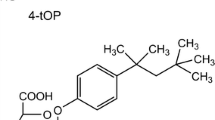Abstract
Apart from its high toxicity1,2, the chemical stability and persistence of 2,3,7,8-tetrachlorodibenzo-p-dioxin (TCDD) in the environment bring about additional hazards3,4. However, until now there has been no evidence for degradation of this dioxin in biological systems, and it is considered unusual that a compound which is insusceptible to biological attack should be so extremely toxic. In in vitro studies5 with microsomal preparations from mouse, rat and rabbit liver, as well as in vivo, no metabolite of TCDD has been detected by several workers6–8. Recent data, showing a lower toxicity of TCDD in rats after stimulation of the hepatic mixed-function oxidase, suggested possible metabolic transformation of this compound9. In the present study, we used tritiated TCDD to search for metabolites in the bile of rats and found marked changes in lipophilicity and mobility in TLC of the excreted radioactivity. Treatment with diazomethane yielded at least two new compounds. These observations hinted at the formation of phenolic hydroxyl groups in the dioxin molecule.
Similar content being viewed by others
References
Oliver, R. M. Br. J. ind. Med. 32, 49–53 (1975).
Reggiani, G. Archs Toxicol. 40, 161–188 (1978).
Kearney, P. C., Woolson, E. A., Isensee, A. R. & Helling, C. S. Envir. Hlth Perspect. 5, 273–277 (1973).
Ward, C. T. & Matsumura, F. Archs envir. Contamination Toxicol. 7, 349–357 (1978).
Vinopal, J. H. & Casida, J. E. Archs envir. Contamination Toxicol. 1, 122–132 (1973).
Piper, W. N., Rose, J. Q. & Gehring, P. J. Envir. Hlth Perspect. 5, 241–244 (1973).
Allen, J. R., Van Miller, J. P. & Norback, D. H. Fd Cosmet. Toxicol. 13, 501–505 (1975).
Fries, G. F. & Marrow, G. S. J. Agric. Fd Chem. 23, 265–269 (1975).
Beatty, P. W., Vaughn, W. K. & Neal, R. A. Toxicol. appl. Pharmac. 45, 513–519 (1978).
Ramsey, J. C., Hefner, J. G., Karbowski, R. J., Braun, W. H. & Gehring, P. J. Toxicol. appl. Pharmac. 48, A162 (1979).
Author information
Authors and Affiliations
Rights and permissions
About this article
Cite this article
Poiger, H., Schlatter, C. Biological degradation of TCDD in rats. Nature 281, 706–707 (1979). https://doi.org/10.1038/281706a0
Received:
Accepted:
Issue Date:
DOI: https://doi.org/10.1038/281706a0
- Springer Nature Limited
This article is cited by
-
Use of different endpoints to determine the bioavailability of polychlorinated dibenzo-p-dioxins/furans (PCDD/Fs) and polychlorinated biphenyls (PCBs) in Sprague–Dawley rats
Scientific Reports (2022)
-
Elimination of various polychlorinated dibenzo-p-dioxins and dibenzofurans (PCDDs and PCDFs) in rat faeces
Archives of Toxicology (1989)
-
Influence of phenobarbital and TCDD on the hepatic metabolism of TCDD in the dog
Experientia (1985)





